Team Analysis: Napoli
On Sunday the 31st of May 2015 Napoli lost 4-2 at home to Lazio in their final game of the 2014-15 Serie A season. The result finally ended Napoli’s slim chances of qualifying for the Champions League in the next season as they finished 5th. To make matters worse (so it seemed) head coach Rafa Benitez was set to leave and take over at Real Madrid, and with Lazio’s emergence under Pioli, Napoli fans could be forgiven for feeling pessimistic. It was an all too familiar feeling of uncertainty for the Napoli faithful only two seasons after Mazzarri left for Inter after guiding them to their highest finish since their Scudetto winning campaign of 1989-90.
Fast forward 10 months and Napoli are in the thick of a title fight with the mighty Juventus and have led the table for much of the season. With 9 games left of the season Napoli had already surpassed last season’s points total, are currently the joint-highest scorers in the league and boast an unbeaten home record across all competitions bar a defeat to Inter in the Coppa Italia quarter final. All within the maiden campaign of the new manager Maurizio Sarri.
How exactly has Sarri overseen this quick turnaround? This article will explain some of the tactical nuances behind their rise.
General line-up and player movements
Schemes of playing out from goal-kicks
“Everything is much easier when the first progression of the ball is clean”- Juanma Lillo.
As Lillo says a clean build-up and progression makes the following offensive actions far easier and this goes some way to explaining Napoli’s insistence on passing their way out from deep in their own half even despite being pressed.
https://twitter.com/1415football/status/714493838346297344
From goal-kicks Napoli occupy positions in order to give Reina as many passing options as possible with their staggered positioning that creates width and depth. This is particularly useful as it helps to stretch the opponents’ shape should they decide to press. Firstly they rotate into something resembling a 3-4-3, with Jorginho dropping onto the same line as Koulibaly and Albiol (often remaining slightly higher) while Ghoulam and Hysaj push on and join Hamsik and Allan in the second line. Higuain, Insigne and Callejon maintain fairly high positions to stretch the opponents vertically while the touchline hugging full backs stretch them horizontally. Reina is integrated well to create connection to the far side and escape the opponents’ pressure.
The three in the first line offer the first passing options for Reina and they are used especially if the opponent does not push up and form situational man-orientations to prevent the short pass. At times Albiol or Koulibaly are still used when marked tightly simply to draw the opponents in and create space on the opposite side which can be accessed via Reina.
The interiors (Hamsik and Allan) on the second line will drop deeper and wider if Reina deems the first line options to be unsuitable. Jorginho, Albiol and Koulibaly then display good understanding and move in order to manipulate the opponents’ positioning and open the passing lanes to the interiors.
By dropping deep and wide Hamsik and Allan pose two questions to their opponents, which are simply how many players they are willing to commit to the press and how far out of their usual zones they are willing to move to support the press? If the opponent commits to pressing and follow the 8s deep into their half they run the risk of exposing their defence against Napoli’s front three.
Furthermore given the relatively high positioning of Napoli’s forwards, if the opponent decides to follow Allan and Hamsik it would create a disconnect between their defensive line and the rest of the team. The alternative is to sit off and allow them to build-up comfortably before establishing a first line of defence at a certain height.
If Hamsik and Allan are marked tightly Reina will play a lofted pass to either Ghoulam or Hysaj. The pass will be played for them to run onto with the aim of drawing the opposing full-back into the duel, they then attempt to head the ball onto the onrushing Insigne or Callejon down the respective flank. This also gives the opposing full-back a decision to make, contest the header and risk the respective winger running free down the line, or risk allowing Napoli’s full-back to bring the ball down unopposed?
After the first pass from Reina the players become very ball-oriented in their movement in order to create strong connections and minimise the possibility of the ball carrier being isolated in possession. At least two of the midfielders drift to the ball side whilst the ball-far 8 remains in the middle to connect the play to the far side if needed. These strong connections help to generate a level of press resistance that gives Napoli the opportunity to bypass opponents’ pressure through combination play.
The ball-near full back drops to provide a wide passing option, whilst the ball-far full-back comes inside and joins the centre-backs to create a situational three man defence to secure against potential turnovers. This is of course necessary given the high focus they display on combinations and quick vertical and diagonal progressions which could lead to frequent possession turnovers.
Improved zonal occupation and midfield balance
During Rafa Benitez’s tenure at Napoli one of the major flaws in their possession game was the inconsistent support offered by the midfield. This was caused by inconsistent positioning which particularly harmed their ability to move the ball into midfield when building from the defence. On an individual level Hamsik did a lot to salvage the connections but even he was (naturally) not omnipresent.
The scene below is from the aforementioned final day home loss to Lazio. The midfield three are all positioned within the centre circle and with Callejon in particular positioned very wide they lack presence in the half spaces. Lopez, Inler and Hamsik are easily covered by Lazio’s midfield and Koulibaly has no real progressive passing options, the switch to Albiol would leave Napoli in a very similar situation, almost needless to say the ball is lost within seconds.
They often suffered from poor central presence due to poor staggering and a lack of focus on the half spaces which often led to a highly wing-oriented construction, slow and unstable progressions. Without support for the ball carrier Napoli were often easily isolated against the touchline and subsequently forced to lose possession.
Step forward Maurizio Sarri who immediately set about improving Napoli’s possession game after his arrival in the summer of 2015. In stark contrast to Benitez’s side Napoli now have a strong central focus in possession (somewhat similar to Dortmund and PSG click the links to view TP’s brilliant analyses of those teams) and manipulate opponents with their circulation and combination-oriented approach far more effectively. Their possession game revolves quite heavily around diagonal or vertical play, quick combinations and other collective actions. In training they can often practice quick one touch combinations to exploit penetrating 3rd man runs and the benefits are clear on match days.
The positioning of the midfielders in Napoli’s build-up is now far more consistent, seemingly through clearer or stricter positional guidelines, as they occupy good positions to offer the defenders the chance to progress quickly. The 8s can be seen acting in their respective half spaces when the ball is in the centre. Jorginho however is particularly ball-oriented in his movement shifting to the ball side and often remaining behind the ball to offer a back pass outlet and a connection to other areas of the field.
In the above image Jorginho has progressive passing options to Hamsik and Insigne available. With either choice the receiver would have adequate space and there would be immediate support available meaning they would not be isolated. Furthermore the diagonal pass to Lopez would be viable through a back pass to Koulibaly, Hysaj and Koulibaly would then move into supporting positions.
In Jorginho, Allan and Hamsik Napoli have a midfield three of different profiles and they demonstrate good synergy in most aspects of the game, particularly their movements in possession. While Jorginho generally conducts the possession play from a deep position there are occasions where he rotates with either Hamsik or Allan.
Due to Jorginho’s importance to Napoli’s build-up, opposing forwards naturally pay a lot of attention to him, however when he rotates quickly with one of the 8s they are often free to build the play as the opponents take a few seconds to react to the changing circumstances. At other times he simply pulls wide and Hamsik or Allan drop onto the same line creating a situational double pivot providing an alternative route for progression.
Build-up and Collective press resistance
Inviting pressure is one of the most important factors in Napoli’s build-up, by inviting pressure Napoli know they if they manage to beat it in a controlled manner they will have excellent attacking prospects. If the opponent can be successfully lured in to press it acts as an offensive pressing trap (as AO detailed in his brilliant Juego De Posicion analysis) due to the space it creates.
In order to draw a press from opponents Napoli provoke a number of typical pressing triggers. Some typical triggers include sideways or backwards passes, passes to wide areas, and more advanced triggers such as loose touches, bouncing balls and players receiving with a bad field of vision. With this knowledge of common pressing triggers it is far easier to lure opponents into pressing and Napoli can be seen using some of them to their advantage.
They often play backwards to invite their opponents forwards before exploiting the newly opened space between the lines, horizontal passes are also used to move their opponents and open lanes for vertical or diagonal passes.
https://twitter.com/1415football/status/714144644779606016
A major trigger they use is players receiving facing the ball square on, while this is not a great body position to take up if the player wishes to progress possession themselves, it assists with inviting opponents to press. This is often done with Jorginho who mostly remains just behind the opposing forwards and receives passes facing the ball square on with the main intention being to attract the attention of opponents and free space for Koulibaly and Albiol to progress.
https://twitter.com/1415football/status/713774758127656965
In order to benefit from these attacking prospects Napoli constantly demonstrate a high level of collective press resistance. This collective press resistance is reached by a combination of a number of factors. One such factor is the sum of the press resistance of the individuals involved. The players involved show the required composure to receive under pressure, commit opponents and play beyond them, this generates a level of press resistance that can be described as the addition of every individual player’s resistance.
Another equally important factor is strategic positioning to create as many and as strong as possible connections and optimal spatial coverage. Press resistance is essentially how well a team can bypass a press and come out with possession, or from the other perspective how hard a team are to press.
Good positioning gives the team in possession adequate spacing and means they can occupy more space in turn making them harder to press. However occupying large spaces is not effective unless there are connections between the players. Without strong connections between players the ball carrier can be isolated easily and forced into possession turnovers. Therefore a rule of thumb is to occupy as much space as possible whilst retaining strong connections between players.
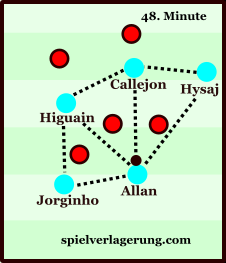
Napoli create strong triangle or diamond-like structures giving the ball carrier an option to play forwards, backwards and to either side.
In addition to the two aforementioned aspects Napoli demonstrate great passing intelligence to generate free men in tight situations despite their opponents often committing enough players to match them numerically. They frequently pass to the blind side of an opponent which has the effect of tempting them to turn out and press the ball, when this happens the opponent leaves the player they were marking thus creating a free man. In order to break free from the press the free man can move into space to support the ball carrier who can lay the ball off and alleviate the mounting pressure.
https://twitter.com/1415football/status/714493101881032704
Napoli benefit from strong and stable circulation deep in their half which is created through the ball-oriented movement of the midfield players meaning they create strong connections and overloads around the ball. Furthermore the high number of Napoli players involved in the build-up requires the opponents to commit several players to press if they wish to prevent an easy progression. This means there will be more numerical equality further up where the Insigne, Higuain and Callejon give Napoli qualitative superiority.
The forwards remain fairly high against the opponents’ back line to occupy and pin them back which often creates a large amount of space for the midfield to progress into. Hamsik and Allan are often seen driving forwards with the ball to take advantage of it if and when the press of the opponents has been beaten.
Diagonal passing orientation and other strategies to create and exploit space between lines
Diagonal passes are fundamental to Napoli’s possession game and particularly how they move the ball into the opponents’ defensive block. The characteristics of diagonal passes (As TP analysed here) have advantages for the upcoming action as opposed to vertical ones and Napoli utilise these effectively.
They often create access to the ten space by passing diagonally into players positioned in line with the opponents’ midfield, often Hamsik or Allan. The standard ball-orientation of defensive units means the areas immediately around the ball are likely to be more densely populated with defenders than areas further away from the ball. Diagonal passes, therefore, tend to go into less densely populated areas than vertical ones meaning the recipient will receive the pass in more space.
Furthermore due to the angle diagonal passes come from, the recipient can receive the ball on the half turn far easier than from a vertical pass where the receiver often has their back to goal. With the pass receiver in more space and able to receive on the half turn the subsequent actions are likely to be more progressive than vertical passes when the receiver has their back to goal and is under pressure.
Due to the aforementioned aspects when Hamsik or Allan receive these diagonal passes they have the required space to play vertically, from where they often play into Insigne, Higuain or Callejon roaming in the ten space.
https://twitter.com/1415football/status/713765774767300609
Napoli’s passes between the lines are almost always made to players that are in the process of moving into that space and the principle of arriving in space as opposed to waiting in it is clear. This approach has many benefits, firstly it is more difficult to prevent the pass given that the player in question does not have a fixed position, thus making such passes easier to complete.
Furthermore the impending receiver is in control of their movement and can thus decide the timing of their movement, whereas the opponent reacts to this stimulus (unless they attempt to predict the movement which is an unstable method). This gives the attacker a slight temporal advantage which can even be extended using an initial stimulus (commonly referred to as “fakes” or “feints”) before proceeding to the actual intended movement.
As the psychological refractory period explains, humans have a relatively long time lapse between responses to a 1st and 2nd stimulus due to the 1st stimulus still being processed (This is why Messi’s body feints and Busquets’ disguised passes are so effective). This slight temporal advantage is inherent in dynamic superiority as Rene Maric of Spielverlagerung conceptualised.
Simply put dynamic superiority refers to having superior timing or speed to an opponent. With their movement between the lines they possess both superior timing (through initiating the movement) and superior speed (due to having more momentum as they began their run earlier) to their opponent. This is particularly useful if the receiving player wishes to dribble past his opponent as most of the work in beating the opponent is done by the time they receive the ball.
At some times they have a seemingly deliberately temporary poor occupation of the ten space with the midfielders acting in front of the opposing midfield line and wide players staying wide. With no players to worry about roaming between the lines the opposing midfielders are lured into a false sense of security and Napoli encourage them to push up and engage Napoli’s midfielders.
This creates large space between the opponents’ lines of defence if they fail to show the required cohesion to push up as a unit. Once the opponents have committed to moving forwards, Napoli’s players, often either Insigne and Callejon or Hamsik and Allan can be seen moving in to occupy the previously vacated ten space.
https://twitter.com/1415football/status/713079718493478913
As mentioned above short passes from the centre backs to Jorginho are often used to invite a press from the opponents. By either positioning himself in the centre or moving from half space to centre Jorginho moves opponents and opens passing lanes from the defenders to players in the half space and between the lines.
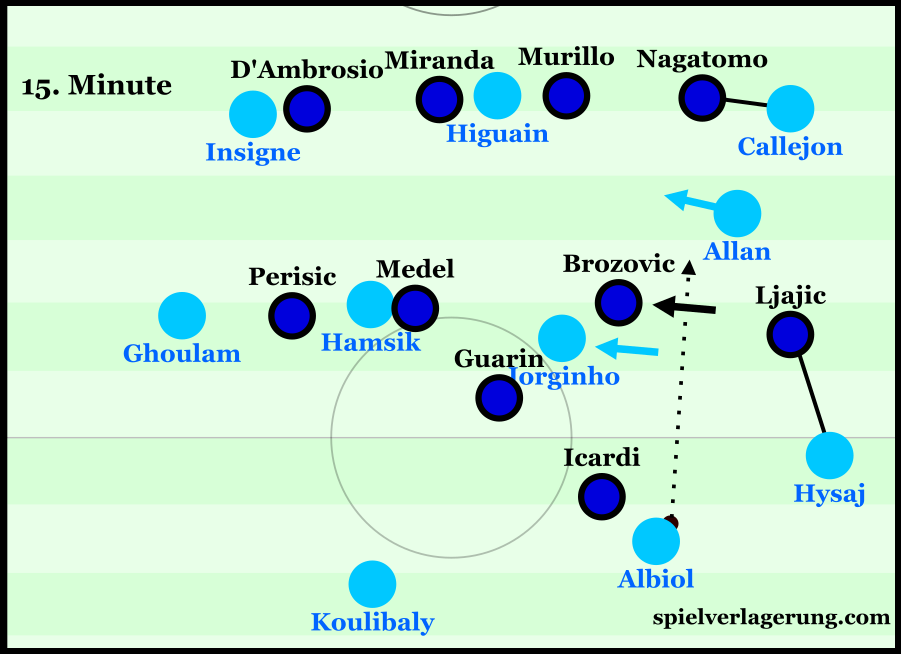
A moment from the 15th minute – Jorginho moves towards the centre to open a passing lane into the right half-space.
Another method used is Insigne’s curved movement. The Italian is afforded a fairly high degree of positional freedom in Sarri’s system fluctuating between the left wing and half space. When he is positioned on the left flank he frequently receives the ball, waits for Ghoulam to overlap, often taking the attention of the opposing wide players, before passing inside and moving towards the ten space to receive a return pass.
By curving his movement Insigne offers an initial stimulus in coming towards the ball before moving forwards, in doing so he takes advantage of the previously mentioned psychological refractory period. Also the movement of Ghoulam and the pass back to Hamsik mean that Insigne can make his movement unmarked if the opponents do not prioritise and organise themselves quickly.
Attack and chance creation patterns
In their chance creation phase Napoli utilise a number of offensive patterns which are all heavily based on collective-actions. In keeping with their possession game, these patterns are based heavily on using the magnet-like qualities of the ball to open the “opposite spaces” before exploiting the possibilities this creates.
One of these patterns is a half space switch, said switches often locate Insigne in the left half space who can then benefit from the various possible actions from the half space. In order to create this space in the left half space Napoli often overload the right side with the ball-oriented movements of their midfield players in addition to Callejon and Hysaj maintaining familiar positions. This will naturally cause their opponents to adjust their defence to create access by shuffling over and leaving the far side understaffed.
Once they have invited the press satisfactorily the players involved will adjust their positions in order to create a connection that allows the switch to be executed cleanly. When Insigne receives the ball he has various actions to choose from including shooting, crossing or dribbling, this unpredictability makes him difficult to defend against. In addition he often goes against the grain of the defence’s movement by coming infield as they come across to engage him, this heightens his advantage. From this position Insigne often plays a chipped cross to Higuain who deliberately runs off the blind side of the ball-far centre back.
Impressively they display collective passing intelligence and are patient enough to use several short passes to invite the press before making the switch in order to increase the room for Insigne to operate in the next phase.
As Lillo says “The principle idea of Positional Play is that players pass the ball to each other in close spaces to be able to pass to a wide open man.”
Another offensive pattern they use frequently is a lofted through ball for Callejon who runs in behind the opposing defence. This scheme shares several patterns with the aforementioned half space switch, as short passes used to lure the opponents in before switching the play to the under loaded side. When the switch is made towards the left, Insigne often receives in front of the opposing defence, on the right however the switch pass is often made in behind the opposing defence for one of Callejon’s trademark depth runs.
https://twitter.com/1415football/status/712042482226360320
Although it isn’t Callejon in this exact situation it is a typical run he makes when he is on the field and in fact Gabbiadini had come on in his position.
Gioco di posizione?
While it is difficult to say for sure that Napoli are practicing full blown positional play, there are a lot of aspects in their game that match the concepts and tools of positional play.
In all phases of their possession game Napoli show a clear focus on disorganising their opponents with their strategic use of possession in true Juego De Posicion style. In build-up this often begins by playing to one side (even if the player is being marked) and creating connections to move the ball to the far side. What this does is lure the opponents to press on one side which opens the space on the other side of the field that can be accessed either through Reina or the midfielders depending on the phase of their build-up. The build-up itself begins very deep with one of the aims being to stretch the opposing team’s block vertically and establish superiority between their lines of defence.
With the ball in the midfield the strategic use of backwards and sideways passes invite pressure from tiring opponents leading to large gaps from where Napoli can benefit from their superiority between the lines. The generating of free men is done through their positional staggering and efficient ball circulation which are of course inextricably linked to one another.
They also utilise overloads to manipulate their opponents’ defensive shape and create connections to the far side to exploit the space they have created. With strong connections around the ball Napoli create positional superiority as their circulation structure is stronger than the defensive structure of the opponents. Many of these aspects can be seen in this wonderful goal against AC Milan in October.
https://twitter.com/1415football/status/712048940674322432
Notice how they initially overload the right side and use several short passes to draw Milan in before Jorginho moves off Bonaventura’s blind side to provide the connection to the left half space. Once they reach the left they play backwards to create a gap between Milan’s midfield and defence which creates a free man (Insigne) between these lines.
Napoli’s vertical and diagonal passing axis in addition to their focus on aggressive support of the ball-carrier and combination play makes their positional game an interesting one. At times the overall positional structure and spatial occupation is weakened in order to create the potential for combination play meaning Sarri has tweaked some of the general concepts of positional play.
Issues against man-marking
Napoli have at times struggled to make their possession game effective agaisnt man-oriented opponents and this is somewhat understandable when you consider the characteristics of both approaches. One of the major tools in Napoli’s possession game is the generation and exploitation of the free man which assists not only with ball retention but helps to open various attacking possibilities. Furthermore accessing and exploiting the space between the space between the opponents’ lines of midfield and defence is another integral part of Napoli’s game. The aforementioned free man is often generated between the lines from where committing and manipulating opponents to create chances becomes a fairly simple task.
Due to the focus on direct coverage of opponents that is inherent in man-marking it can be more difficult to generate free men against. Furthermore the lines of midfield and defence are far less clearly defined with a man-oriented approach as the defensive team’s positioning is wholly determined by the opponents. For this reason playing between the lines can be dificult against an aggressive man-oriented defence.
As mentioned above Sarri’s game model is based heavily on collective actions right from the build-up through to the offence. Man-marking however seeks to pitch the game into a series of 1v1 duels and at times Napoli have not been able to adapt their methods to be effective against this. This was evident in the recent loss to Udinese where they lacked effective positional rotations to manipulate their opponents, and their usual collective actions were sub-optimal with almost every advanced receiver under immediate pressure.
When their collective actions do not come off, Napoli can be vulnerable to offensive sterility and they do not appear to be at ease with a more individualistic attacking approach. This is understandable given that the qualities of their attackers seem more suited to a team-oriented approach.
Zonal marking coverage scheme
“With Sarri it is the ball which determines the movements of the defensive line, while with Allegri you work much more on the man”-Daniele Rugani August 2015.
Napoli are also very impressive out of possession and Sarri has implemented a strong option-oriented zonal marking system. In an option-oriented zonal system the main positional reference point is the ball and with Napoli space (relative to the ball) and team mates’ movements follow behind. Thus the defence will shift, press and cover depending on the position of the ball but also in anticipation of the ball’s next move as they attempt to restrict attacking possibilities.
Theoretically an option-oriented zonal system has advantages over several other common defensive strategies. Firstly man-marking, whilst man-marking can be useful to create access it is a highly reactive strategy as the positioning is completely determined by the opponents’ movement which hands them the advantage as they can then create space in desired areas with their positioning and movement.
This also relates to other issues with man-marking which are a lack of shape/compactness and thus control of vital zones. Due to its reactivity man-oriented defences lack a defined shape, and being an individualistic defensive approach the individual team members are often too separated to provide support or cover for each other in defensive actions. For these reasons man-marking lacks the ability to control vital zones of the field. In simple terms man-marking is bad.
A well implemented position-oriented zonal marking (See RM’s zonal coverage article for an explanation) system is good for controlling vital zones with good compactness and defensive support, perhaps more so than any other system. However the system lacks the access required to force possession regains as it is very passive, this scheme thus often requires long periods of concentration to wait for the opponents to make an error.
While man-oriented zonal marking can be described as entailing the strength of man-marking in establishing access and the strength of position-oriented zonal marking in maintaining a level of control over certain zones with a cohesive shape, it falls to another fallacy of man-oriented approaches.
Two big characteristics of man-marking are that players stick tightly to the opponent and often stay goal side. This means man-oriented defences often regain possession through tackles and the player who just received the ball is immediately faced by an opponent (player they were just marking). Furthermore due to initially being goal side of the opponent the player who regains possession often has to beat their marker to launch a counter. Man-oriented systems are therefore quite weak for the transition to attack.
With a well-executed option-oriented zonal system a team can maintain control of important zones through maintaining a good shape with compactness and team support. Access can also be created without compromising the shape as the team-mates cover the ball-oriented movement. Furthermore due to the passing lane focus this access can lead to clean turnovers through interceptions and the ball winner often has no immediate opponents to beat which is of course beneficial for the next action.
Within their zonal system Napoli situationally move from their base 4-1-4-1/4-5-1 into a situational 4-4-2/4-4-1-1 structure as the midfielders step out to engage the ball carrier joining Higuain in the first line of defence. When this player leaves the midfield line to engage the ball carrier the remaining midfield four either narrow up to cover the space vacated or situationally orient themselves to the nearby opponent.
Another interesting feature that is evident in the first image is the movement of the far side players, Hamsik in particular. This diagonal movement from the ball far players is inherent in Napoli’s pressing scheme. In mid and deep block defensive phases the ball near 8 is usually responsible for pushing up to engage the opposing ball carrier. When pressing against the opponents’ build-up however the ball-near players often sit back and cover while the responsibility to create access falls to the ball-far 8 and ball far winger. In these moments Napoli often move into highly compact, lop sided 4-3-3/4-3-1-2 situational structures.
Higuain either remains in front of the ball to cover back passing options or presses the ball covering central and backwards passes. The ball-far 8 moves in diagonally and uses their cover shadow to prevent passes into the space they have just vacated and the ball-far winger supports in this movement to create high compactness around the ball giving Napoli the chance to create access. The near side players create a situational chain beneath the first pressing line covering options behind the situational front three.
This movement is particularly effective at trapping and even isolating opponents in unstable areas and subsequently forcing possession turnovers. The ball-far players moving up as opposed to near side players doing so creates some interesting effects. Firstly it gives Napoli a high level of horizontal compactness as the opposite flank is practically vacated. This compactness means they can aggressively push towards the ball carrier whilst maintaining a level of stability through the potential supporting actions of team-mates in the vicinity.
The diagonal movement paired with the covering movements of the ball-near players creates a layered or staggered press which is helps secure the defence in case of the first line being beaten. With Napoli’s extreme density around the ball the opponents are often forced into suboptimal actions such as long balls down the flank or long horizontal switches.
The potential downside of this pressing scheme relates more to the execution than the concept. Due to the far side being practically vacated if Napoli’s press is beaten they will struggle to shift to the opposite flank in time to prevent the opponents from taking advantage of the space.
The above image is a typical pressing scene from Napoli’s 2-1 home win over Juventus. Several of the above concepts are on show and Chiellini (the ball carrier) is left without a viable passing option. In this game Juventus attempted a number of cross field switch passes in an attempt to take advantage of Napoli’s narrowness. The problem is that Sarri’s men create access well with this pressing movement which means the ball carrier lacks the time and space to play this pass accurately and they often result in the turnovers Napoli aim to force.
Transition defence
All aspects and phases of the game are of course constantly interacting and many of the previously discussed aspects in Napoli’s possession game have implications for what happens when they do lose the ball.
Firstly their aggressive support of the ball carrier means they often have several players in the vicinity when the ball is turned over thus helping them to establish access and forcing the opponents to lose possession. Furthermore their central focus in their positioning means the opponents often have to go wide to find space from where their counter attacks become less dangerous, more predictable and subsequently easier to manage.
In their counterpressing they show a passing-lane orientation as the players position themselves in lanes to block passes in an attempt to force the opponent into long dribbles. These long dribbles would slow down the opponents giving Napoli time to recover good defensive positions and narrow down the variety in potential actions for the opponent making them easier to control. For this reason Napoli don’t always appear to be counterpressing as they don’t always prioritise immediate access to the ball. However they control the situation by forcing the opponent into predictable actions by controlling the vital zones with their positioning.
With the ball-far full-back tucking in to create a situational back 3 the ball-near centre back can push out to the wing more aggressively in order to win the ball back through tackles or interceptions. With his intelligent positioning and physical prowess Koulibaly is particularly proficient when isolated against opponents on the left flank and frequently wins possession in these areas.
Expected Goals
| Position | Team | xGD |
| 1. | Barcelona | +48.1 |
| 2. | Bayern Munich | +42.7 |
| 3. | Real Madrid | +37.2 |
| 4. | Borussia Dortmund | +36.9 |
| 5. | Napoli | +32.2 |
| 6. | Arsenal | +29.3 |
| 7. | Juventus | +25.1 |
| 8. | Tottenham | +23.4 |
| 9. | Man City | +22.4 |
| 10. | Atletico Madrid | +17.5 |
The table above shows the expected goals difference (according to Michael Caley’s model) for some of Europe’s top teams. Expected goals difference (xGD) is the difference between shots created and shots conceded which incorporates the quality of these chances not simply the sheer volume. Based on predictive analyses, by Michael Caley and 11tegen11, it is shown to have a high correlation to future success, i.e. goals scored and goals conceded.
As the table shows Napoli have the fifth highest sum across the La Liga, Bundesliga, Serie A and Premier League which indicates the strength of their league performances this season.
Conclusion
With 7 Serie A games remaining Napoli sit in 2nd place, 6 points behind last year’s champions after a wobble in February left them 5 games without a win in all competitions, and a seemingly annual collapse at Udinese. This mid-season wobble unfortunately included the heavyweight clash with Juventus and raised doubts over their ability to sustain their title challenge over the season. They have since responded in imperious fashion with three consecutive wins and some excellent expected goals numbers.
Sarri compromised Napoli’s chances of a potential mouth-watering battle for the Europa league with Dortmund by resting key players to focus fully on their Scudetto charge. It would be an outstanding achievement were Napoli to overhaul Juventus and claim their first Serie A title since 1990. However nothing should be taken away from them should they fall short, and the strong tactical system Sarri has implemented in his first season bodes well for the future.
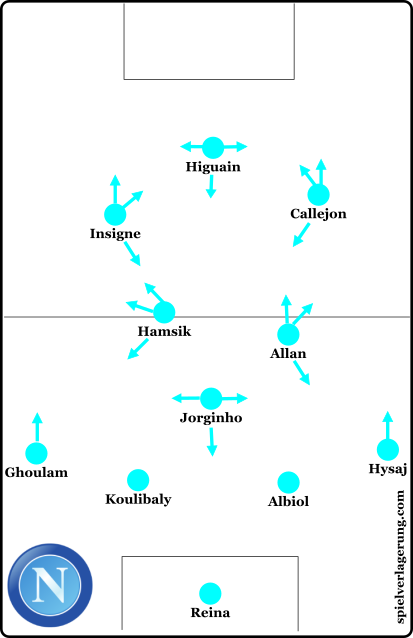
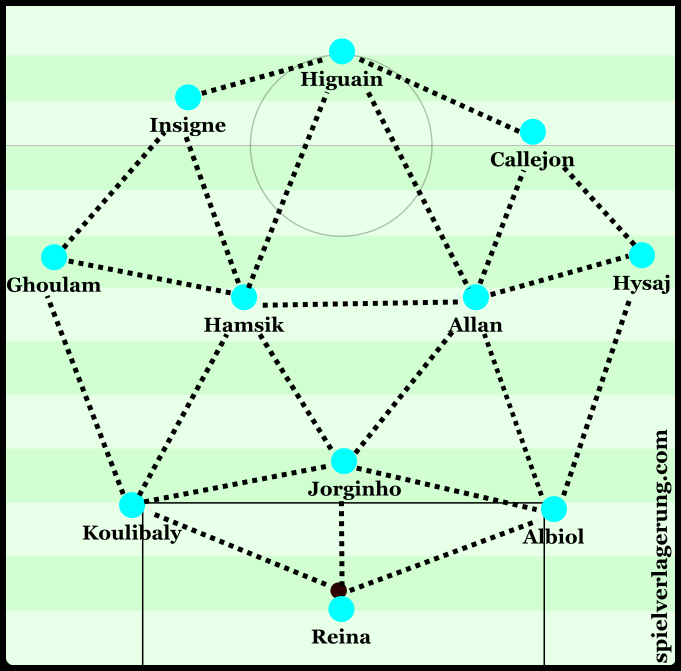

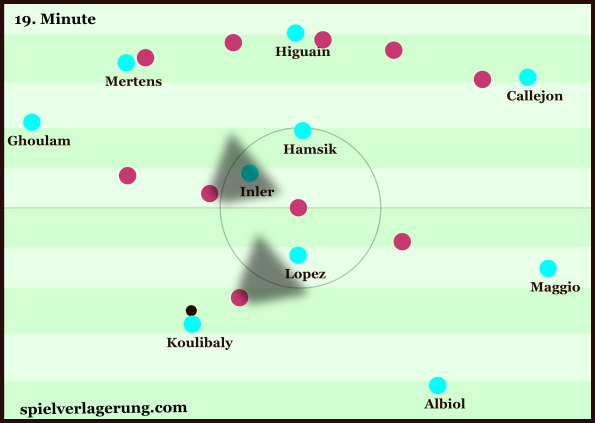


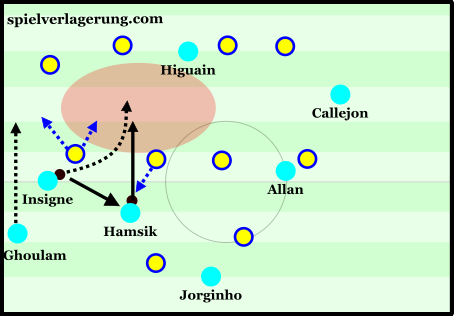
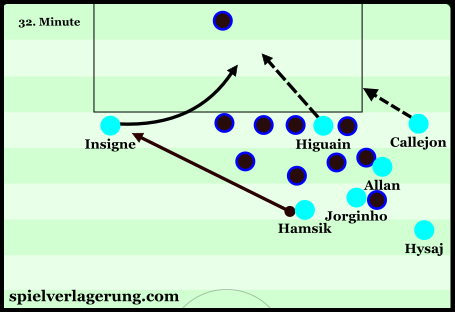
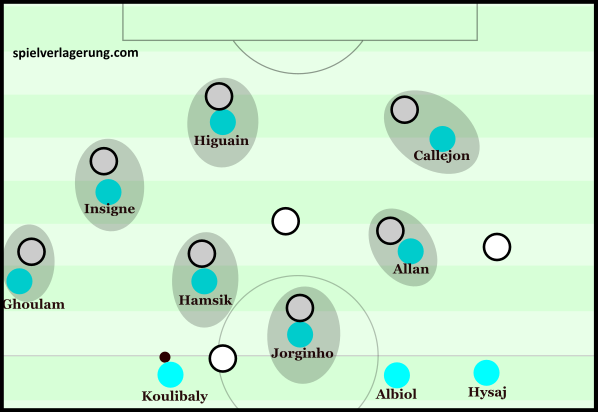
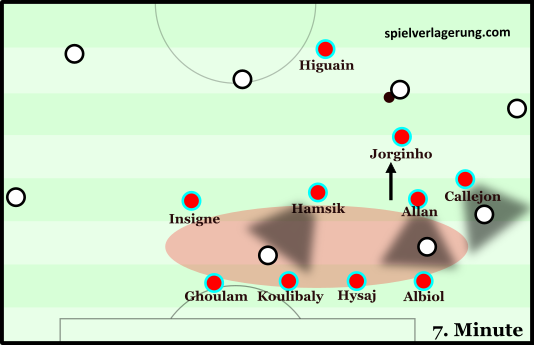
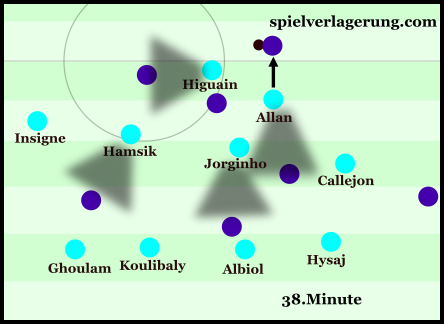
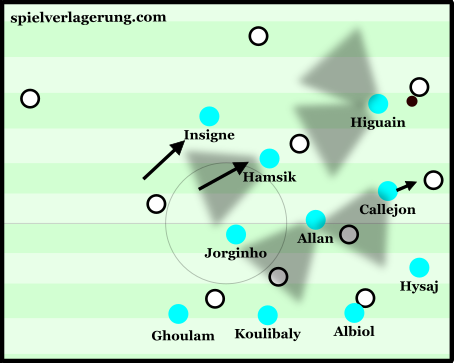
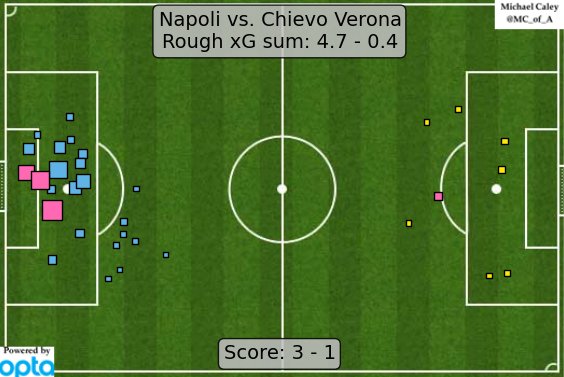
6 Kommentare Alle anzeigen
Dario May 12, 2016 um 4:49 pm
Fantastico! BRAVO JD
LosLobos April 9, 2016 um 2:57 pm
Astonishing! So much great information, going to have to read this through three or four more times at least – I don’t think my brain can absorb all of this in one attempt.
André April 8, 2016 um 8:47 pm
This is the best football article I have ever read. The comprehensive attention to all aspects of their game is unbelievable and the transition between the macro and micro aspects of their tactics is so smooth.
JD April 8, 2016 um 11:15 pm
Wow, thank you Andre!
Patric April 10, 2016 um 10:26 am
I agree with André. This is a great piece of work! Thank you for this, JD.
André April 11, 2016 um 4:24 pm
Just read it for a second time and it’s still fantastic. I certainly didn’t mean that original comment as a slight on any of the other articles on this site (which are almost universally awesome), but to write something of this length, while presenting all the detail in such a balanced way is unreal.
Only thing that could perhaps be added is a discussion of their objectives at attacking transitions and the micro tactics which help them to achieve such objectives.